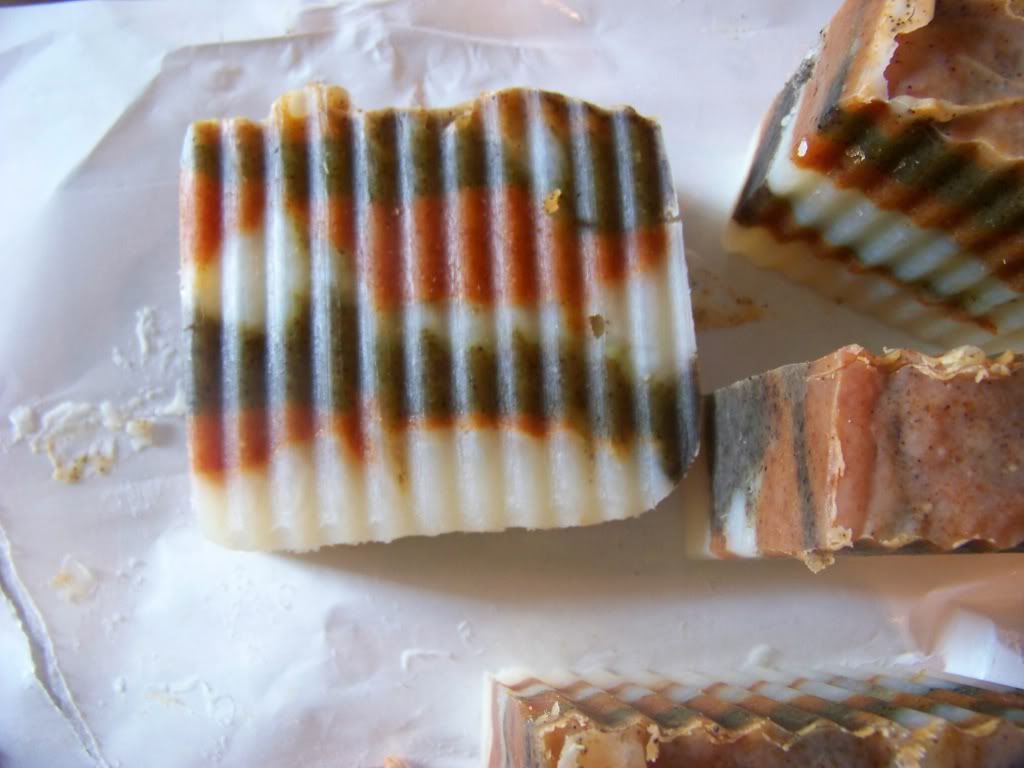Sandalwood Powder will give a purplish red to a maroon color, depending upon the PH level. A lower PH will give a more maroon coloring and a higher PH will give you a purplish coloring. Use at 1/2 teaspoon per pound of oils.
Alkanet Root Powder gives a pinkish red to a bluish purple coloring, also depending upon the PH level. A PH of 6 will have a red color, a PH of 8 will be lavender/purple, and a higher PH will be more blue. For every two ounces of base oil, infuse one tablespoon of alkanet. For your soap, add about four tablespoons per five pound batch of soap.
*of course the amount you use and the types of oils in your formulation also influence the final color.
For a green color in your soaps try some;
Burdock Leaf gives a nice, natural green. This is best when infused in a base oil, either by the hot or cold method.
Comfrey Leaf will also produce a nice, natural green. The leaves can be infused in the base oil, using one part comfrey to two parts oil, or you can add the leaf powder straight into your batch at light trace, one tablespoon per pound of oils. You can also infuse the powder into the base oil, but you will need to use a cheesecloth to strain it prior to using it.

Dandelion Leaf powder is also good for a green. Use one to two tablespoons per pound of oils at light trace, or infuse in your base oil.
Then we come to my personal favorites;
*The above photo is of my Bamboo Soap and is made with cocoa powder and spirulina for coloring.
Nettle Leaf Powder, which gives a green that is pretty close to a lime green. It can be added directly into your soap pot or it can be infused into your base oils, whichever you prefer.
And Spirulina, which gives a nice, rich green. This works best when added straight into the soap pot. Depending upon the shade of green desired, adding 1/2 to one teaspoon in a five pound batch is generally recommended. Although I have seen it as high as one teaspoon per pound of oils.
You can also use; French Green Clay, Alfalfa, Chlorophyll, or Olive Leaf powder for various shades of green.
Cherry Bark Powder makes a nice warm, reddish-brown color. Use two tablespoons in a five pound batch of soap. It is best to take one cup of your batter out and mix the tablespoons in. Once you have it well incorporated, mix that cup back into the whole batch.

Tomato Powder makes a nice tomato red color, but it also has the scent of tomato since it is the actual dehydrated fruit.
This soap is a tomato soap and the green and brown coloring is from Neem powder.
Rattanjot will make a light lavender brown color to a deep purplish brown in your soaps.
For Browns try;
Walnut Hull Powder will produce a rich, nutty brown color in your soap. Add 1/4 teaspoon per pound of oils. For a deep, dark brown use up to 1/2 teaspoon per pound of oils. This is a great additive for creating a swirl color or a nice contrast color.
*The picture to the right is of my Kitchen/Gardener Soap. It is colored with coffee and has coffee grounds in it as well. It also has a small amount of cocoa powder sprinkled on the top.
Cocoa powder also makes a natural, deep brown that is great for contrast and swirls. Mix one tablespoon into 1/2 cup of your soap batter at trace, then mix that half cup back into your entire batter.
 The middle layer of this Citrused Lavender soap is cocoa powder. The picture isn't nearly as pretty as the soap is in real life. The brown swirly layer really pops! The bluish bottom is a combination of blueberry fibers, indigo, and vanilla powder.
The middle layer of this Citrused Lavender soap is cocoa powder. The picture isn't nearly as pretty as the soap is in real life. The brown swirly layer really pops! The bluish bottom is a combination of blueberry fibers, indigo, and vanilla powder.*Correction! The brown in this soap is actually vanilla powder.
Coffee and Coffee Grounds also make a nice brown coloring for soap, not to mention that the grounds make a wonderful scrubbing additive.
Poppy Seeds will be a blue gray to black flecks in your soaps.
Blues are the most difficult colors to achieve naturally, but it can be done! A plant that is high in azulene will give a nice blue, even though it may fade when its left for a long period of time. So (Common) Yarrow, botanically known as Achillea Millefolium, Blue Tansy, and German Chamomile are your flowers of choice for blue.
Then there is also;
Woad Powder is a nice sky blue color in soap and you only need 1/8 to 1/2 of a teaspoon per five pound batch of soap, depending upon how deep a color you want.
And Indigo Powder, which will give you a more denim blue, but still with only 1/8 to 1/2 of a teaspoon for a five pound batch of soap!
Frequently I will mix one or more of the coloring agents to create a deeper shade of a color or even a new one all together. Play with them and find your own color combinations! The picture above is of my Orchid Rain (a proprietary blend), colored with a mixture of cranberry powder and blueberry fibers
In case I forgot to mention, as I think I did, Clays, for coloring, should be added at a rate of one tablespoon per pound of oils, either to the hot oils or at thin trace.





No comments:
Post a Comment